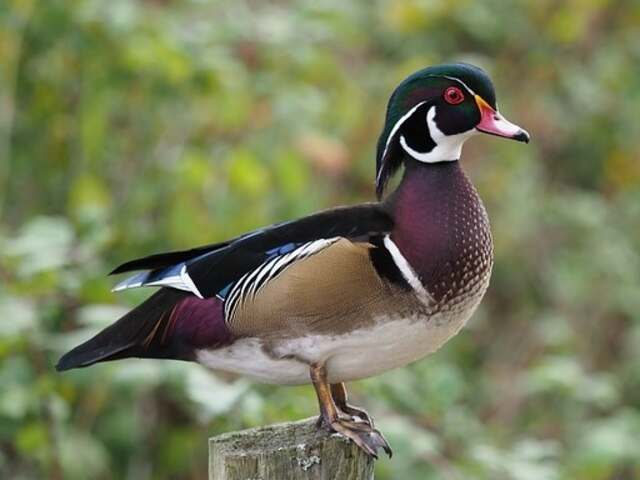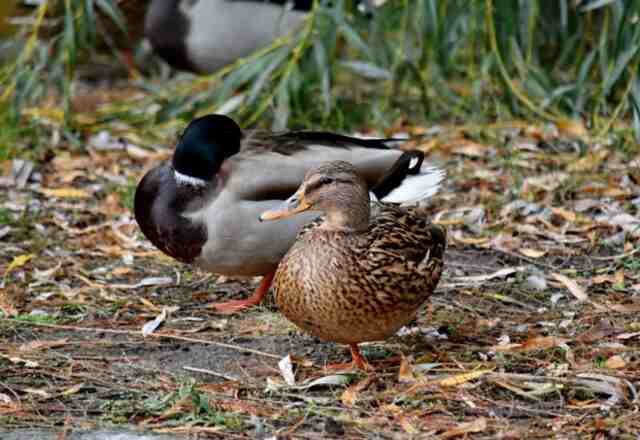Imagine standing by a serene lake, watching the gentle ripples of the water and feeling the cool breeze against your skin. Suddenly, a group of ducks waddles towards you, quacking loudly with their heads held high.
The sound echoes across the water, breaking the peaceful silence and capturing your attention. But have you ever wondered why do ducks quack in the first place? Well, my friend, you’ve come to the right place.
In this article, we’ll explore the fascinating science behind duck communication and the various reasons why they quack.
From social hierarchies to warning signals, reproduction to learning, and even the evolution of quacking, we’ll take a deep dive into the world of duck quacking and uncover some fun facts along the way.
So, buckle up and get ready to quack your way through this informative journey.
Table of Contents [show]
The Science Behind Duck Communication
You might be surprised to learn that there’s a fascinating science behind how these feathered friends communicate with each other. Duck vocalizations, or quacks, aren’t just random sounds. They serve a purpose in the duck world.
Different types of quacks have different meanings, and ducks use them to communicate with each other. Researchers have studied duck vocalizations and have found that they have unique acoustic properties.
Duck quacks have different frequencies and patterns that are used to communicate different things. For example, a female duck might quack in a certain way to tell a male duck that she’s interested in mating.
Males, on the other hand, might use a different type of quack to establish dominance over other males. Duck communication strategies are complex and involve a variety of different calls and sounds.
Understanding the science behind duck communication can help us appreciate these fascinating creatures even more.
By listening to their quacks, we can learn about the social hierarchies among ducks and how they interact with each other.
In the next section, we’ll explore these social hierarchies and how they impact the behavior of ducks.
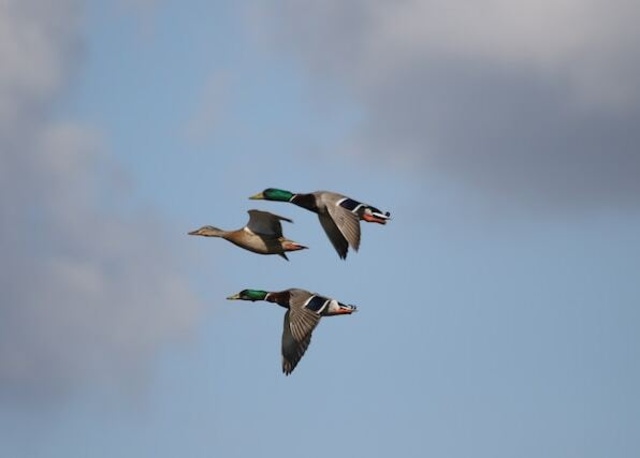
Social Hierarchies Among Ducks
In the world of ducks, there’s a social hierarchy that’s communicated through a variety of vocalizations and body language.
Pecking order dynamics play a key role in establishing these hierarchies, as ducks use aggression and dominance to establish their place within the group.
Vocalization patterns are another way in which ducks communicate their social status, with more dominant birds using louder and more frequent quacks to assert their dominance.
Social behaviors are also a key indicator of a duck’s place within the hierarchy. More dominant ducks are often seen leading the flock during migration or foraging, while subordinate ducks follow behind.
Additionally, dominant ducks may engage in preening behaviors to assert their status, while subordinate ducks may exhibit submissive behaviors such as avoiding eye contact or lowering their heads.
Understanding social hierarchies among ducks is important for researchers studying their behavior, as well as for those interested in keeping ducks as pets.
By recognizing the signs of dominance and submission, caretakers can ensure that their ducks are living in a healthy and stress-free environment.
Additionally, understanding these dynamics can help us better understand the complex social lives of these fascinating birds, including why they quack for attention.
Quacking for Attention
If you want to understand why your feathered friends make so much noise, listen closely to their vocalizations, as they’re a fascinating way in which these birds communicate and assert their dominance.
Ducks are known to quack for various reasons. Some quack in response to stimuli, such as hearing a loud noise or seeing a predator nearby.
Others have distinct quacking patterns that they use to identify one another, while some quack in different species to establish dominance over their competitors.
One of the most common reasons why ducks quack is to get attention. When ducks quack loudly, it can attract the attention of other ducks, especially if they’re trying to communicate a message or warn them of potential danger.
For instance, a mother duck may quack loudly to alert her ducklings to follow her, or a male duck may quack to attract a mate during the breeding season.
By quacking, ducks are able to communicate with one another, and establish their place in the social hierarchy.
In addition to social communication, quacking also plays an important role in reproduction. During the breeding season, male ducks will often quack loudly to attract the attention of potential mates.
This quacking is a way of advertising their presence and availability to females.
If a female duck is interested, she will respond by quacking back, and the two will continue to communicate in this way until they mate.
Quacking is just one of the many unique ways in which ducks communicate with each other, and it’s fascinating to observe their behavior and vocalizations.
| Subtopic | Description |
|---|---|
| Quacking for Food | Ducks may quack to signal hunger or to beg for food. |
| Quacking for Companionship | Ducks are social animals and may quack to get the attention of other ducks. |
| Quacking for Grooming | Ducks may quack to get the attention of other ducks for grooming purposes. |
The Role of Quacking in Reproduction
When it comes to finding a mate, male ducks use their unique vocalizations to catch the attention of potential partners and communicate their availability.
These vocalizations, also known as mating calls, are an important part of courtship behavior and are used to attract females.
Male ducks use a variety of different calls, each with its own purpose, to communicate their interest to females. One of the most important roles that quacking plays in duck reproduction is in egg fertilization.
After a male duck has successfully attracted a female with his mating calls, the two will engage in courtship behavior that includes preening, head bobbing, and other displays of affection.
During this time, the male will use his quacks to signal his readiness to mate and encourage the female to lay her eggs.
If all goes well, the female will lay her eggs and the male will fertilize them, leading to the growth and development of a new generation of ducks.
In addition to its role in reproduction, quacking also plays an important role in duck communication more generally.
For example, ducks may use quacks to communicate danger or warn each other of potential threats. This is particularly important when ducks are in groups, as it allows them to coordinate their movements and avoid danger.
Overall, quacking is an essential part of the duck’s vocal repertoire and plays a crucial role in their ability to survive and thrive in their natural habitat.
| Subtopic | Description |
|---|---|
| Mate Attraction | Male ducks may quack to attract female ducks during mating season. |
| Nesting Calls | Female ducks may quack to signal that they are ready to mate and to attract males for nesting purposes. |
| Courtship Calls | Ducks may use quacks as part of their courtship displays. |
Quacking as a Warning Signal
You may not realize it, but you can learn a lot about potential danger in a duck’s environment just by listening to their vocalizations. Can you imagine how important it is for these animals to have a warning signal that they can use to protect themselves?
Duck quacks can serve as an alarm call to signal the presence of a predator, and it’s an effective way of predator detection for ducks. Here are some ways that quacking serves as a warning signal for ducks:
- Quacks can indicate the presence of a predator: When ducks detect a predator in the area, they emit a series of loud quacks that can alert other ducks in the vicinity of the potential danger.
- Alarm calls can trigger group communication: When one duck sounds the alarm, it can trigger a chain reaction of quacking from other ducks in the area. This group communication can help to warn other ducks of the impending danger.
- Quacking can help ducks avoid danger: By emitting this warning signal, ducks can take evasive action and avoid potential danger.
Overall, quacking plays an important role in helping ducks to protect themselves from predators. However, ducks also use quacking for other purposes, such as establishing their territory.
By using different types of quacks, ducks can communicate with one another and establish their social hierarchy.
Let’s take a closer look at this in the next section.
| Subtopic | Description |
|---|---|
| Predator Alert | Ducks may use a certain quack to signal the presence of a predator. |
| Distress Call | Ducks may use a certain quack to signal danger or distress. |
Quacking to Establish Territory
Establishing dominance is a crucial aspect of a duck’s life, and quacking plays a significant role in this process.
Ducks use their vocal patterns to communicate with each other, especially during territorial disputes. Quacking is a way for ducks to establish their dominance and mark their territory.
When ducks quack, they are sending a message to other ducks in the area. This message could be a warning, a greeting, or, in the case of territorial disputes, a message of dominance.
By quacking loudly and repeatedly, ducks are letting other ducks know that they are the ones in charge of that particular area.
In this way, quacking is essential for ducks to establish their dominance and protect their territories. Overall, quacking is a crucial part of a duck’s life, especially when it comes to establishing their territory.
In the next section, we’ll explore the different types of duck quacks and what they mean.
| Subtopic | Description |
|---|---|
| Aggressive Calls | Ducks may use aggressive quacks to establish dominance over a certain area. |
| Boundary Calls | Ducks may use quacks to signal the boundaries of their territory. |

Different Types of Duck Quacks
Get ready to learn about the various types of duck quacks and what they signify!
Ducks communicate through quacks, and different species have their own unique vocalizations. For instance, Mallard quack variations can range from high-pitched peeps to low, raspy calls.
Pekin duck quack patterns, on the other hand, are usually loud and repetitive, while Muscovy duck vocalizations are more like hisses and grunts.
Even within a single species, ducks can use different quacks to convey different messages.
For example, a female duck might use a soft quack to tell her ducklings to follow her, while a loud, aggressive quack might be used to warn off potential threats.
Male ducks also use different quacks to attract mates during breeding season. By listening to the tone, volume, and frequency of a duck’s quack, you can often tell what it’s trying to say.
Understanding the different types of duck quacks can be helpful for birdwatchers, farmers, and anyone who spends time around ducks.
By paying attention to the sounds ducks make, you can learn a lot about their behavior and emotions.
Next, we’ll explore how ducks learn to quack, and how they use their vocalizations to communicate with each other.
| Subtopic | Description |
|---|---|
| Mallard Quacks | The classic “quack” sound most commonly associated with ducks. |
| Teal Quacks | A high-pitched quack used by some species of teal ducks. |
| Pintail Whistle | A whistle-like call used by male pintail ducks during courtship. |
| Wigeon Call | A nasal-sounding call used by some species of wigeon ducks |
How Ducks Learn to Quack
As you delve into the topic of how ducks learn to vocalize, a fascinating world of avian behavior and communication opens up.
Duck vocalization development is a complex process that starts shortly after hatching. Ducklings begin to peep and cheep, mimicking the sounds of their mother.
As they grow older, their vocalizations become more sophisticated, and they start to develop their own unique quack dialects.
Parental influence on quacking is significant, as ducklings learn most of their vocalizations from their mother.
The mother duck will communicate with her offspring through various calls, such as the ‘come here’ call, the ‘danger’ call, and the ‘food’ call.
These calls help the ducklings learn to associate specific sounds with certain events or actions. As ducklings grow older, they begin to experiment with their own vocalizations.
They will mimic the sounds of other ducks and try to develop their own unique quacking style. This experimentation is essential for the development of their own quack dialects.
By the time they are fully grown, ducks will have developed a unique quack that is specific to their species and even their individual identity.
This ability to communicate through quacking is crucial for their survival in the wild, as it helps them communicate with their peers and avoid predators.
As you’ve learned about how ducks learn to quack, it’s fascinating to see how their vocalizations develop. Next, we’ll explore how ducks adapt their quacking to different environments.
| Subtopic | Description |
|---|---|
| Hatching | Ducks learn to quack in the egg and start making sounds before hatching. |
| Imitating sounds | Ducks learn to quack by imitating the sounds of other ducks in their environment. |
| Trial and error | Young ducks experiment with different sounds and pitches until they develop their own unique quack. |
Quacking in Different Environments
Have you ever wondered why ducks quack? In our previous subtopic, we discussed how ducks learn to quack. Now, let’s explore how ducks quack in different environments.
Ducks are known for their distinctive quacking sound, which they use to communicate with each other. When ducks are on water, they tend to quack more frequently.
This is because water amplifies the sound of their quacks, making it easier for them to communicate with each other.
Additionally, when ducks are in flight, they quack to stay together and maintain communication. During migration, ducks use different types of quacks.
They use a high-pitched quack to communicate with other ducks in the flock, and a low-pitched quack to communicate with ducks that are farther away.
This helps them maintain communication and stay together during their long journey. As we can see, ducks use quacks to communicate with each other in different environments.
In the next section, we’ll explore the evolution of quacking in ducks.
| Subtopic | Description |
|---|---|
| Social context | Ducks use different quacks to communicate with other ducks in their social group. |
| Warning calls | Ducks have specific quacks to warn others of potential danger. |
| Mating calls | Male ducks have a distinct quack to attract female ducks during mating season. |
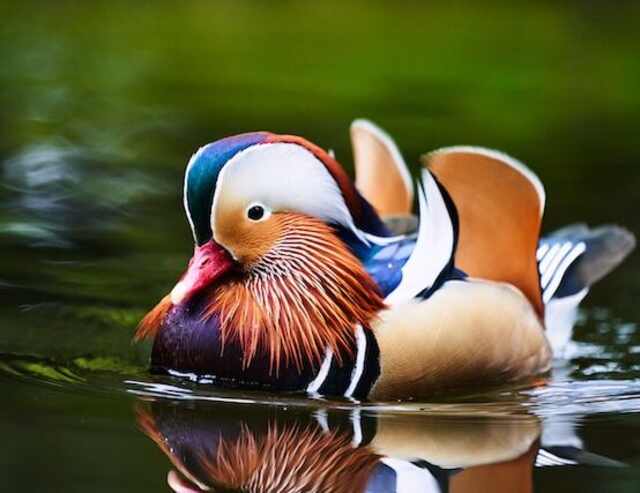
The Evolution of Quacking in Ducks
The evolution of quacking in these feathered creatures is a fascinating tale of adaptation and survival. Over time, ducks have developed evolutionary adaptations that have allowed them to communicate effectively with their peers.
One such adaptation is the vocal cord anatomy, which has allowed them to produce a wide range of vocalizations, including quacks.
Selective pressures have also played a crucial role in the evolution of quacking in ducks. As the environment changed, ducks had to adapt to new conditions, and this included developing new ways of communicating.
For example, ducks that lived in densely populated areas had to develop louder quacks to be heard over the noise.
Similarly, ducks that lived in areas with predators developed softer quacks to avoid drawing attention to themselves.
Today, ducks have a variety of quacks that they use for different purposes. Here are some fun facts about duck quacking that you may not know:
- Female ducks have a softer quack than males, which is thought to be because they’re more vulnerable to predators during nesting season.
- Some species of ducks, such as the wood duck, have a whistling call instead of a quack.
- Mallard ducks have a distinctive quack that’s often used in cartoons and movies.
- Ducks use different types of quacks to communicate with one another, including greeting calls, warning calls, and courtship calls.
As you can see, the evolution of quacking in ducks has been a complex process that has allowed them to survive and thrive in a variety of environments.
By understanding how ducks communicate with one another, we can gain a deeper appreciation for these fascinating creatures.
| Subtopic | Description |
|---|---|
| Ancestral vocalizations | Scientists believe that ducks’ quacking evolved from the vocalizations of their dinosaur ancestors. |
| Adaptation | Quacking has evolved to help ducks survive in different environments and communicate with other ducks. |
| Sexual selection | The evolution of quacking may have been influenced by sexual selection, as female ducks are attracted to males with the most distinct quacks. |
Fun Facts About Duck Quacking
Get ready to be blown away by the fascinating and quirky facts about the way these feathered creatures speak their minds!
Ducks are known for their unusual quackalities and surprising quackitudes. Did you know that not all ducks quack? In fact, only female ducks quack, while male ducks make a raspy, quiet sound.
Quirky quackeries don’t stop there. Ducks have a unique vocalization system that allows them to produce a variety of sounds. They can quack, honk, whistle, and even growl!
Moreover, ducks have individual voices that are distinguishable from each other. This means that ducks can recognize their flock mates’ voices and communicate with them.
If you think that ducks only quack to communicate with each other, you’re wrong. Ducks also quack for other reasons. For instance, some species of ducks quack while flying to maintain their flight formation.
Additionally, ducks can quack to express their emotions. A happy duck will quack louder and more frequently, while a distressed duck will quack softly and infrequently.
It’s amazing how these little birds can convey so much with just one sound!
Frequently Asked Questions
How do ducks sleep?
When it comes to sleeping habits, ducks have unique sleep patterns that differ from other birds. They’re not strictly nocturnal, but they do sleep more during the night and less during the day.
Ducks have the ability to sleep with one eye open, allowing them to stay alert to potential predators while they rest. They also have the ability to sleep while floating on water, using a special mechanism in their legs to keep them afloat.
Additionally, ducks often seek out safe and sheltered areas to sleep, such as hidden spots among vegetation or under overhanging branches. Overall, ducks have adapted to their environment by developing sleep patterns that allow them to rest safely while still being aware of their surroundings.
What is the lifespan of a duck?
Ducks have a lifespan that varies depending on the species and environmental factors. Migratory patterns, breeding habits, and predator threats all play a role in determining the life expectancy of a duck.
Some species, like the mallard, can live up to 20 years in captivity but typically only live for 5-10 years in the wild. This is due to the dangers they face while migrating and breeding, such as predators like foxes and raccoons.
Despite these challenges, ducks continue to thrive and adapt to their surroundings, making them a fascinating species to observe. Habitat loss and hunting also contribute to the decline in duck populations and their lifespan.
How do ducks mate?
To understand how ducks mate, you need to be familiar with their reproductive anatomy and courtship behavior.
Duck mating rituals involve the male duck, or drake, attracting a female with courtship displays, such as head bobbing and preening.
Once the female, or hen, is interested, the drake will mount her from behind and use his cloaca, a common opening for feces, urine, and reproductive fluids, to transfer sperm to the hen’s cloaca.
This process is quick, lasting only a few seconds, and may be repeated with multiple partners during mating season.
Understanding duck mating rituals and reproductive anatomy can help you appreciate the unique and fascinating aspects of these waterfowl’s lives.
What do ducks eat?
Imagine you’re a birdwatcher strolling along the riverbank, and you see a flock of ducks paddling in the water.
As you look closer, you notice they’re foraging for food, diving under the surface with effortless grace.
Ducks are omnivorous birds, which means they have a varied diet of both plants and animals.
Their feeding habits and dietary preferences depend on their species, habitat, and season.
Some ducks prefer to eat insects, crustaceans, and small fish, while others enjoy munching on seeds, grains, and aquatic plants.
Ducks have a unique feeding behavior called ‘dabbling.’
They tip their heads down and paddle their feet to stir up the mud and water, allowing them to reach the food at the bottom.
Overall, ducks are fascinating creatures, and observing their feeding habits is a delightful experience.
How many different species of ducks are there?
Did you know that there are over 120 different species of ducks?
Each species has its own unique migration patterns, habitat preferences, and breeding behaviors.
Some ducks, like the mallard, are found all over the world while others, like the Madagascar pochard, are only found in one specific location.
When it comes to breeding, male ducks will often display elaborate courtship behaviors to attract a mate.
And as for habitat, ducks can be found in a variety of environments from freshwater lakes and rivers to saltwater estuaries and even the open ocean.
It’s truly fascinating to learn about the diversity of these waterfowl species!
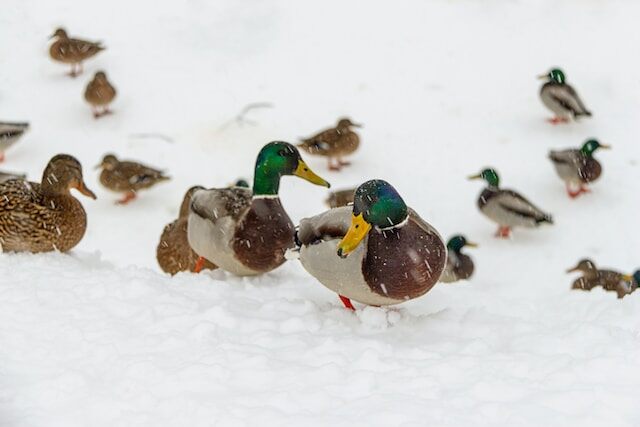
Conclusion
Now you know why ducks quack! It’s all about communication, from establishing social hierarchies to attracting a mate. They can also quack as a warning signal and to get attention.
And just like humans, they learn to quack from their mothers and pick up different variations in different environments.
Next time you’re near a pond or lake and hear the familiar sound of quacking, think of ducks as a community of creatures with their own language.
Watching them interact and communicate can be just as fascinating as listening to a group of people chatting away.
Like a beautiful symphony, the quacking of ducks can evoke feelings of calm and harmony, reminding us of the wonders of nature.


